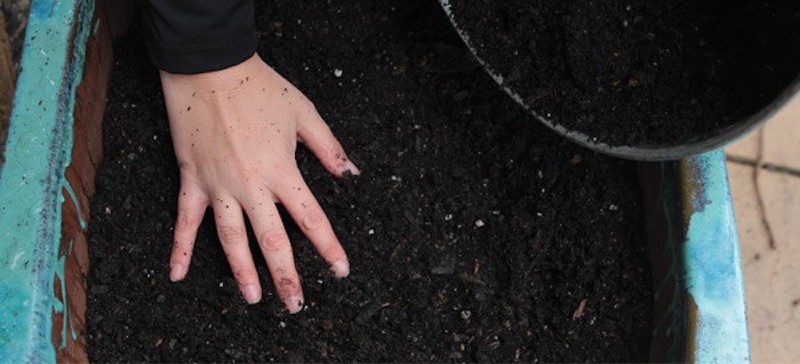Native broadleaf evergreens can be grown beautifully in containers for a long time. The best varieties to choose are the lower growing and compact dwarf types that get no more than 4 feet in height and width. Evergreens are useful for year-round interest at a front entrance or on a deck or patio. The lovely, small evergreen foliage is a nice backdrop for seasonal annuals or can be used on its own for a more formal look.

Planting Mountain Laurel in Pots
The best location for a potted Mountain Laurel is somewhere that has dappled shade for most of the day or bright shade. This will encourage healthy blooming and growth better than a spot in deep shade. The container needs to have excellent drainage and be at least 24 inches in diameter. Using rocks or other non organic items at the bottom of most containers to improve drainage is not necessary. Multiple holes at the bottom of the pot is much more effective. Planting in a pot with a wide base will ensure that the plant does not get top heavy as it grows. Since Mountain Laurel will be in the same pot for many seasons, the choice of pot matters. Depending on your climate, terra cotta or concrete pots may not survive the freezing and thawing of the winter. There are many plastic, resin and even metal containers that will last for years with very little care.
Best Soil for Mountain Laurel
The easiest way to plant Mountain Laurel is to use a premixed potting soil that is formulated for acid-loving plants. An organic formulation is the best choice and fortunately many companies now produce sustainable mixes. All-purpose potting soil can be used as long as some amendments are added. A slow-release fertilizer formulated for acid-loving plants can be mixed well into the potting soil before planting. Follow the manufacturer's recommendation on the package. Mulching the top of the container will help to keep the soil moist longer, cooler and prevent weeds. Using finely shredded bark will break down over time and need to be reapplied. Using an inorganic material like glass chips, river pebbles or gravel will last a long time and have a more modern feel.

Care For Mountain Laurel in Planters
Mountain Laurels in pots need a little extra care than those grown in the ground, but are quite happy to be in a container their whole life if you provide adequate water, fertilizing and winter care.
Watering Mountain Laurel in Pots
Water until the soil is completely soaked and excess runs out of the drainage holes. Plants will need watering when the top 2 inches of soil has dried out. Plants in the ground will typically need 1 inch of water a week. Shrubs planted in pots will need to be watered much more and need to be monitored on a daily basis during the hottest part of summer. Placing pots in areas that can be rained on is beneficial and can mean far less watering. Keep in mind that plants placed under a porch or near the house may not get wet when it rains.
Fertilizing Mountain Laurel in Pots
Feeding plants in containers is a very important part of their maintenance. A slow-release fertilizer is the easiest to use and should be scattered around the top of the pot in early spring. Application of diluted liquid fertilizer such as kelp and fish emulsion should be done once a month through the beginning of August. Always follow the manufacturer’s recommendation and stop feeding in August so that the plants can begin the process of hardening off for winter dormancy.
Winter Care for Mountain Laurel
Mountain Laurels in pots have far less natural insulation than garden-grown plants. This means that container-grown plants should be treated as if they are growing in a colder hardiness zone in the winter. In zone 7, potted Mountain Laurels should be treated as if they are in zone 5. Pots may need to be moved to a more sheltered area out of prevailing winds and storm paths. Also, keep in mind that shady spots in the summer can become quite sunny in the summer because of the angle of the sun or lack of leaves from deciduous trees. Full sun, even in winter, will cause severe burning of Mountain Laurel's evergreen leaves.
Make sure that whatever container you are using will make it through a winter of freezing and thawing without cracking or completely breaking apart. Glazed terra cotta is tougher than unfinished pottery, but plastic and composite are sure to make it to the next year. Plastic and composite containers also retain more moisture, which could result in far less watering needed during all seasons. Make sure drainage of the pot is excellent and consider raising the pot up on bricks or dedicated “pot feet'' so there is no chance of the container sitting in standing water for any period of time.
Supplemental watering is rarely needed through the winter months, unless the container is in a spot that is sheltered. The soil should feel like a wrung-out sponge all through the winter. Anything wetter or drier will stress out the shrub.
Growing Mountain Laurel indoors
Mountain Laurel is not intended to be a houseplant and should not be brought indoors to grow. This is a shrub that needs a certain period of cold weather and dormancy to spark healthy growth in the spring.
 |
Author Robbin Small - Published 6-29-2022 |
